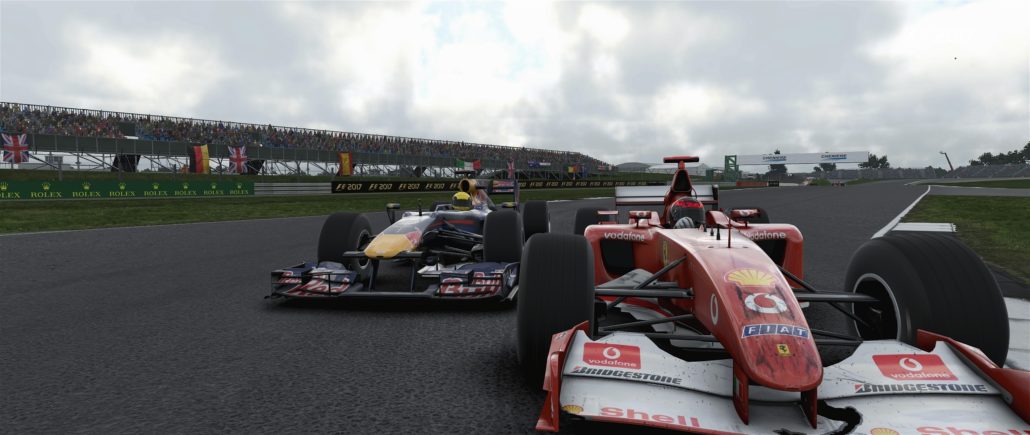Formula One isn’t exactly the most entertaining motorsport in the world. At least that’s the case if you’re after action that decides the podium.
This year is already better than last which saw Mercedes vs Mercedes in a battle lacking any sportsmanship. 2017 has featured surprise placements like Stroll’s third.
Plus there’s been a good show of sportsmanship from Hamilton to Bottas. Vettel and Hamilton are, of course, the best of friends after Azerbaijan.
This little introduction says nothing about F1 2017, does it? That’s because, on the more difficult of settings, you’re unlikely to see much in terms of action.
You’re either riding in the best car and you’re going to put up a challenge, or you’re not. In reality and in-game, one of the more interesting aspects of Formula One are the strategic and tactical decisions. It’s less about racing than it is pre-planning and a bit more planning after that.
At least this is the case if you want it to be a simulation of the sport. Fortunately, the game doesn’t force this on you. You’ve got many choices when playing F1 2017.
My preference is a more arcade style while still utilising the new features that Codemasters have included. Looking for something that goes into the finer details?
This is the game for you. DRS, fuel management and even restrictions on power units, everything counts. More than that, your particular racing style has a huge impact on the wear and tear of your vehicle.
Much like you would expect from a racing simulation, you’re able to go into the finer details of your car. You’re given the option to adjust everything from the aerodynamics and weight distribution of your car, to your fuel load and of course tyre pressure.
Even the smallest of changes can make the biggest of differences, for better or worse. This is where the game really shows the effort that’s gone into it, the racing and the realism of every straight and corner.
Provided you’ve got fuel consumption turned on and other settings at least somewhat trending towards realism, you’ll find the game is incredibly tense to play.
The physics are fantastic and the feel of the cars is absolutely brilliant. There’s little doubting that you get drawn up into the speed of the cars, growing in confidence with every successful lap. Even better is that thrill you get in a challenge race, going to-and-fro with another rider.
Of course, this confidence can come to a grinding halt at any time. It’s staggering how easy it is to spin out of control. The slightest of errors, just one wheel going onto the grass can end your race instantly. At the same time, even the smallest collision can result in the same thing. Just as in real life, Formula One cars have a surprising tendency to break apart like Jacobs cream crackers at the slightest provocation.
As good as the racing is, there is one large problem. This being the AI. Too often have I been penalised for colliding with another racer or having been run off track. The game seems to suffer from the problem of all incidents involving the human player is always the fault of the human.
Not only that, but no matter the AI setting I’ve had problems with being run into even from behind on a straight. In a further way of punishing you, challenges like passing through gates on a corner will often fail for an inexplicable reason.
At the end of the challenge, it will break down the failures and often give a reason like “too slow” when the on-track guide was actually indicating to slow down.
Starting your new career as a driver is likely the main draw of F1 2017. Career mode has been vastly improved over last years outing, particularly due to the management side of things. Rather than linear lines of development as in last years game, there’s a smorgasbord of upgrades to choose from.
You buy them through spending upgrade points.
These upgrades can do anything from giving a small but needed boost to your performance or the car’s durability to dramatically alter and bring your season back from the depths. However, an upgrade can also fail and be an incredible waste of the annoying to earn upgrade points.
During the career, you’ll have a number of objectives in the practice sessions of a grand prix. Five of these are always identical: Track acclimatization; tyre management; fuel saving; qualifying pace and race strategy. Each of these offers a maximum of 50 resource points each, challenging you to meet particular requirements. The most difficult of these, for me, is tyre management.
You need to go around the track at a particular time while preserving your tires as much as possible.
These challenges help to acclimatise you to the tracks as well as improve your riding abilities. More than this, it also plays a key part in your race strategy. One thing I’ve found myself very adept at is fuel conservation. More than a few times I’ve started a 15 lap GP with enough fuel for 14 or 14.5 laps.
Taking your foot off of the acceleration, letting yourself freewheel into a corner and slowing naturally saves a considerable amount of fuel over time. Starting with less fuel lowers your weight and can, of course, increase your speed.
Of course, the overall aim is to be the world champion. Keeping your eye on the driver and manufacturer rankings will always be a major thing.
In addition to this, you’re given rivalries as you progress through your career. Surpassing your rival by beating them in qualifying and in the race itself is always good.
As well as beating your rival and seeing your standing within the team go up, you can also see your reputation amongst other manufacturers. Once it hits a high enough level you’re likely to get a contract offer from one of those.
To ensure the career mode doesn’t get too stale Codemasters have also included a number of invitational events in F1 2017. These events range from racing through checkpoints to passing other cars, all within a time limit.
Of course, these sort of events are nothing unusual in racing games, but they add a nice bit of variety in a season mode which is otherwise just regular races. What these events also offer is the chance to race in some classic cars.
This actually highlights another area that F1 2017 shines. Both visually and audibly, the game is fantastic. In particular, the cars have an exquisite amount of detail.
Every square centimeter has been carefully designed and rendered. As pointless as it may seem, being a racing game, but the detail of people has been increased a lot over last year. Rather than looking like a model from the world’s worst wax works, they’re now that bit more realistic.
It’s the audio that really takes the cake in F1 2017, though. The cars sound absolutely fantastic, from the engines to even the most minor of collisions.
This is exemplified best by the invitationals or any race you take in an older F1 car. One of the large problems with the racing now is that the cars just don’t sound like they have that power.
Racing in the older cars and listening to the roar of the engine is F1 racing at its best.
The game also gives you a fair amount of content outside of the career. You’ve got mutiplayer, which is par for the course now. However, in addition to this, there are also championships that task you with various types of races and events and some that put you in a range of classic cars. Some, even, put you on street-only tracks that feel like an even more insane version of Formula E
There’s little more than can be said about F1 2017 than it’s the best in the series. From the extended and more detailed career to the host of other modes available to play, you’ll not find yourself getting bored. The game looks, sounds and feels fantastic.
There’s little doubting it has annoyances like the AI making idiotic decisions and the game then blaming you for them as well as detection issues for some challenges, but even these end up feeling like minor issues in what is otherwise an excellent game.






